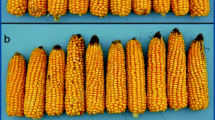Abstract
A time course study was carried out to assess the appearance and distribution of DON in different organs of forage maize cultivated in the field. DON was produced after the flowering period and increased until harvest to high amounts in the rudimentary ears and leaf sheaths/leaf blades deriving from nodes located below the ear node, whereas nodes and internodes were either not or only slightly contaminated with DON. Genrally, DON was not detected in the ears, including husks, during the whole cultivation time.Fusarium biomass determined in the infected organs confirmed these findings. It seems that the contribution of DON containing rudimentary ears, leaf sheaths and leaf blades to the total DON contamination of forage maize is so far widely underestimated. Therefore advanced evaluation procedures are recommended to get a better understanding of the infection and contamination process and to prove genotypic differences in the resistance of forage maize genotypes againstFusarium infection.
Similar content being viewed by others
References
Lew H, Adler A, Edinger W, Brodacs W, Kiendler E, Hinterholzer J (2001)Fusarium species and their toxins in Austrian maize. Die Bodenkultur 52 (3) 199–207
Schollenberger M, Müller H-M, Drochner W. (2005)Fusarium toxin contents of maize and maize products purchased in the years 2000 and 2001 in Germany. Mycotoxin Research 21 (1): 26–28
Oldenburg E, Ellner F (2005)Fusarium mycotoxins in forage maize — Detection and evaluation. Mycotoxin Research 21 (2): 105–107
Nedelnik J (2002) Damage to corn by fungi of the genusFusarium and the presence of fusariotoxins. Plant Protection Science 38 (2): 46–54
Asran MR, Buchenauer H (2003) Pathogenicity ofFusarium graminearum isolates on maize (Zea mays L.) cultivars and relation with deoxynivalenol and ergosterol contents. Journal of Plant Diseases and Protection 110(3): 209–219
Munkvold GP (2003) Epidemiology ofFusarium diseases and their mycotoxins in maize ears. Eur J Plant Pathol 109 (7): 705–713
Goswami R S, Kistler HC (2004) Heading for disaster:Fusarium graminearum on cereal crops. Mol Plant Pathol 5 (6): 515–525
Oldenburg E (1993) Occurrence of zeralenone in maize. Mycotoxin Research 9: 72–78
DiMenna ME, Lauren DR, Hardacre A (1997) Fusaria andFusarium toxins in New Zealand maize plants. Mycopathologia 139 (3): 165–173
Tian S, Wolf GA, Weinert J (2005) Accurate assessment of wheat and triticale cultivar resistance toSeptoria tritici andStagonospora nodorum infection by Biotin/Avidin ELISA. Plant Dis 89 (11): 1229–1234
Isebaert S, DeVreese R, Haesaert G, Fremaut D, Vlaemynck G, Maene P (2003) The distribution ofFusarium mycotoxins in maize: preliminary results. Parasitica 59 (3/4): 87–96
Pauly C, Ramseier H, Spring P (2005) Factors affecting mycotoxin contamination of corn. Tagunsband 27. Mykotoxin-Workshop Dortmund, Institut für Arbeitsphysiologie der Universität Dortmund (ed), 13–15, Juni 2005: 32
Author information
Authors and Affiliations
Corresponding author
Rights and permissions
About this article
Cite this article
Oldenburg, E., Höppner, F. & Weinert, J. Distribution of deoxynivalenol inFusarium-infected forage maize. Mycotox Res 21, 196–199 (2005). https://doi.org/10.1007/BF02959262
Issue Date:
DOI: https://doi.org/10.1007/BF02959262




